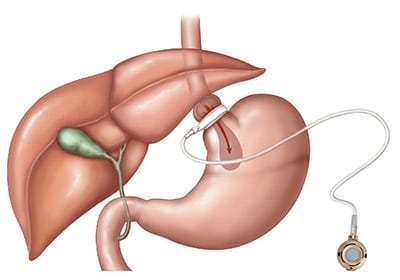The adjustable gastric band is another option for weight loss surgery. It is among the top of least invasive weight loss procedures and it typically only takes about 30 minutes to an hour. It is done with a few tiny cuts in the abdomen, where the surgeon puts the necessary surgical instruments. The surgeon will use these tools to place a band around the top portion of the stomach, leaving a very small pouch available for food and the rest of the stomach below the band. Attached to the band is thin tube leading to an access port that is left under the skin. This access port is there so your doctor can insert a needle to inject or remove saline. Adding saline tightens the band and makes the stomach smaller, and removing saline would occur if the band became too tight. Adjusting the size of the opening is done gradually over time, with repeated adjustments or “fills”. During the surgery, the band will not be inflated with saline. You will need to recover from the procedure before the band is adjusted for weight loss—this usually happens 4 to 6 weeks after surgery. Once the band begins to be adjusted, gradual and steady weight loss should follow.
After this procedure, you may need pain medication to help with discomfort and soreness. You will be given strict instructions on what you can eat post surgery. For the first two weeks, your stomach will only be able to handle small amounts of liquids while you are healing. Some people feel full after only a few sips of water or other clear liquids. Others don’t experience that extreme of a difference. But either way, it is extremely important to sip water throughout the day to avoid dehydration. It is common for your bowel movements to be irregular post surgery, but be sure to stay as hydrated as possible to avoid constipation. Bit by bit, you will be able to add solids back into your diet. You must be careful to chew food very well and stop eating as soon as you feel full. This will take some getting used to, mainly because it will take a significantly less amount of food to make you feel full. But if you do not chew well or stop eating when you’re full, you’ll be likely to experience extreme discomfort and possibly nausea and vomiting. Talk with a dietician to ensure you get the adequate nutrients you need while continuing to eat in very small portions. Once you start eating solid foods again, your doctor will adjust the band around your stomach by injecting sterile saline into the port under your skin, which will inflate the band and cause it to tighten. You may have several band adjustments in the first year post surgery to find the right size for you. You will need to visit your doctor for each band adjustment.
Some disadvantages and risks of this procedure are: slower and less early weight loss (compared to other weight loss surgeries), requires a foreign object (the band) to remain in the body, there is a greater percentage of patients that fail to lose 50% of excess body weight (compared to other popular weight loss surgeries), this procedure has the highest rate of re-operation, there is a small percentage of patients that have band slippage or band erosion into the stomach, can result in esophagus dilation if the patient overeats, and it requires post surgery adjustments.
It is important to know all the risks and disadvantages in order to make the best choice, but here at the advantages you should consider as well: it involves no cutting of the stomach or rerouting of intestines, the surgery requires a much shorter hospital stay (typically less that 24 hours!), it is a reversible and adjustable procedure (unlike other weight loss surgeries), has a lower risk of vitamin and mineral deficiencies, has a lower rate of early complications and mortality among other weight loss procedures, and induces excess weight loss of 40-50%–with the weight loss being more gradual and steady than other procedure produce.
Each weight loss procedure has it’s pros and cons, as you’re learning. I know this decision is difficult and intimidating, but talk to your healthcare provider about your options, it may help ease the anxiety. We will be discussing one more weight loss procedure in the following blog.


